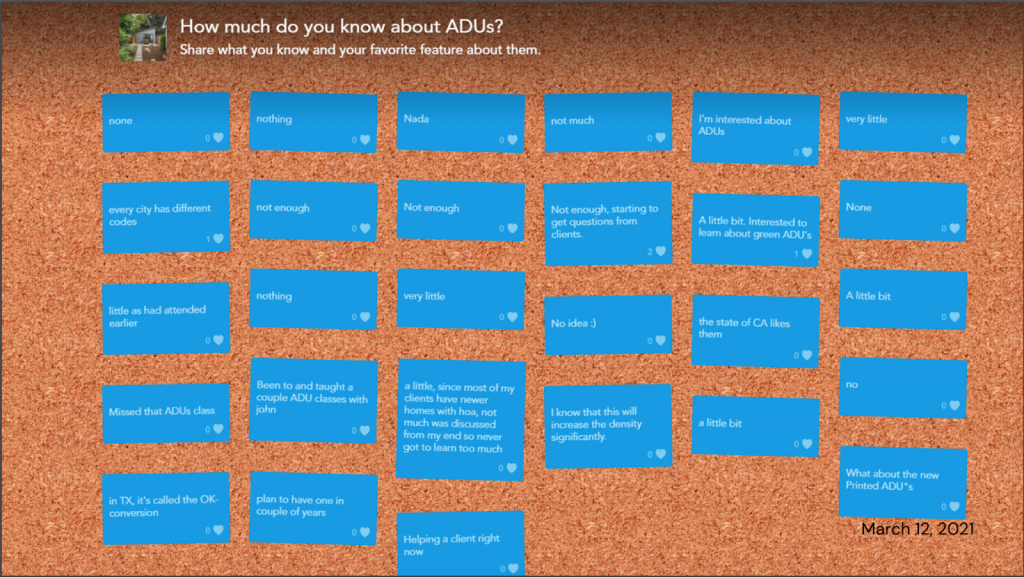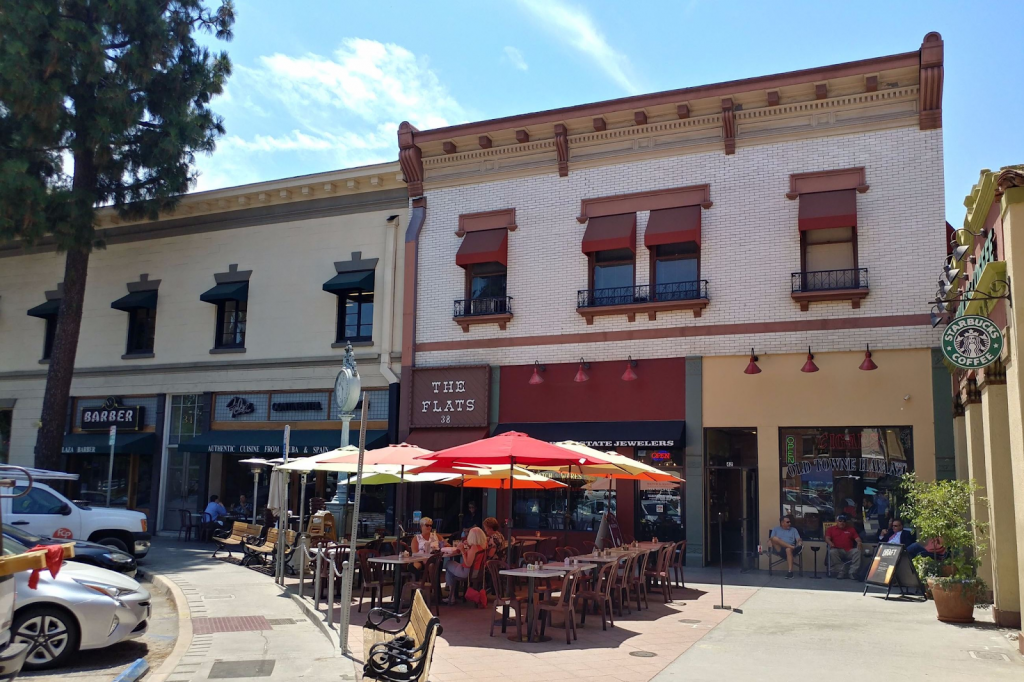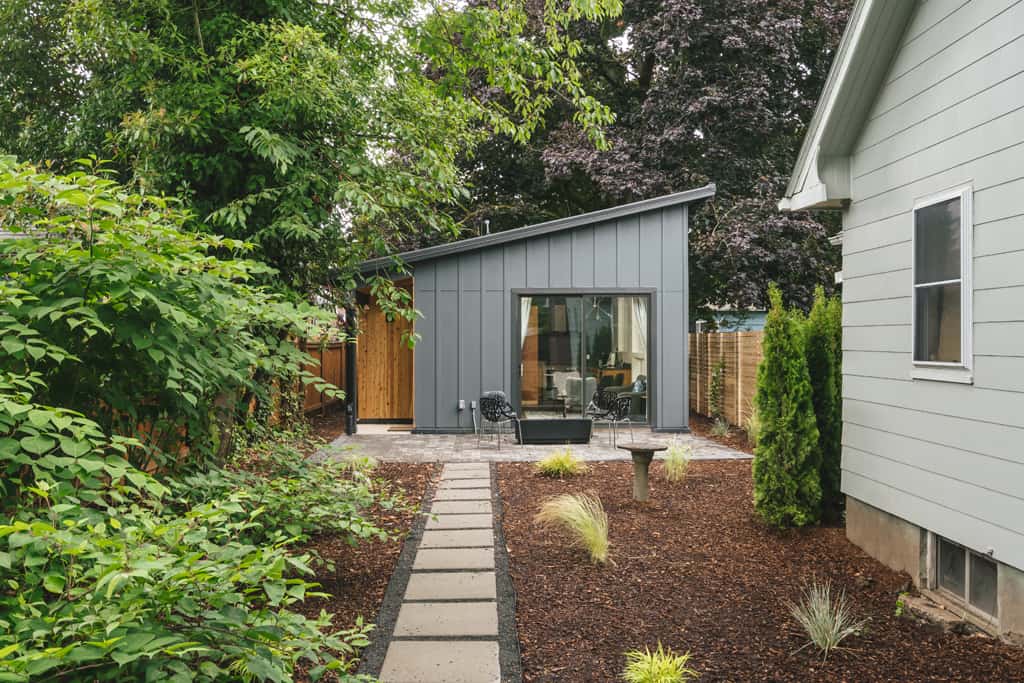Build It Green staff members, Hannah Bruegmann and Chloe Chapman, spoke with the Orange County Realtors Association® about how ADUs can be used to meet the housing and environmental needs of individuals and communities without sacrificing a location’s unique qualities, and even enhancing them, and the roles realtors can play making this future a reality.
This past March, the Orange County Realtors’ Green Committee hosted their first Green Week, a 5-day event featuring webinars and classes taught by experts in the green building space. We joined the festivities as the event’s final guest speakers, leading a session titled “The Intangible Value of Place.” Throughout, we encouraged participants to think critically about what makes a location unique, how ADUs can help preserve a place’s unique qualities over time while also enhancing them, and the role realtors can play in building healthier communities.
When people hear the word “webinar” these days, they generally know what to expect. But after a year of all things remote, we wanted to try something a little different: giving an interactive presentation using a tool called Nearpod, to help the group learn more about each other and see the big picture of what we all cared about. To do that, we started by asking participants questions about their careers and knowledge of green building, and they were able to watch their answers appear on the screen in real time.

Though most participants were long-time realtors and Orange County residents, many cited knowing “very little” or “not much” when it came to green homes—particularly ADUs—and a desire to learn more, demonstrating our shared interest and connection on these topics.
The value of a place
To get the group thinking, we posed a simple question about Orange County: “what makes this place unique?” We briefly walked through some of the county’s major historical moments—from the indigenous tribes who occupied the land for thousands of years to the area’s late-19th-century agricultural growth—to ground the conversation in the area’s history.
To no one’s surprise, Disneyland was cited multiple times as a location that makes the county unique, but it was far from the only answer. The responses we saw highlighted a huge range in the county’s built, natural, and human environments, with participants referencing qualities like nice weather, age diversity, and the abundance of natural areas as a few of the things that make Orange County special. These responses highlighted all the unique ways in which a place is special, how those qualities are valued by residents and visitors, and gave us a starting point to think about what direction we’d want to encourage ADU development to take.


After recognizing these qualities we’d want to preserve, we acknowledged the reality that, like many other parts of California, Orange County is rapidly growing. Rising populations and necessary housing development, coupled with the reality of a shifting climate, mean that changes in the county’s beloved urban and natural environments are inevitable.
ADUs and preserving community identity
We encouraged participants to think of ADUs as powerful tools that can be used to handle and overcome these major challenges, while preserving the characteristics and qualities of the place that are so beloved. On an individual scale, ADUs can serve as affordable housing options that also give the gift of flexibility. They can be rented out, bringing in additional income for a homeowner, or be used as spaces for family members who unexpectedly move back home—something that has been a particular need in the age of COVID-19.
From a community perspective, ADUs have the potential to improve age diversity by allowing for intergenerational living, bolster racial diversity by allowing tenants to live in areas they would otherwise be unable to afford, and become multi-use spaces for the whole community.

Green building gives us an opportunity to be able to meet the needs of climate change, meet the needs of a growing community, but do it in a way that maintains or enhances the things that we absolutely love about the places where we live.
- Hannah Bruegmann, Build It Green Tweet
Critically, we wanted to get the group thinking about how ADUs can be developed with the characteristics of a place in mind and seen as an asset for not just a single homeowner, but a whole community. An Orange County ADU, for instance, could use solar to take advantage of the area’s sunlight, have a mission-style exterior to match local architecture, and be built using locally sourced materials to reduce shipping-related emissions. And that’s just one example. No matter where you live, ADUs give individuals and communities an effective way to meet developmental and environmental demands while preserving a location’s identity.
The role of realtors (and all of us)
Before wrapping up, we wanted to leave participants with an optimistic thought: that realtors have a special role to play when it comes to getting more (and greener) ADUs built in their communities.
Realtors are often the first people with whom new residents interact and establish a relationship. Not only can they teach their clients about green home options initially, but they can also help them identify key resources and opportunities to make building an ADU as cost-effective as possible.
When we asked participants about their role in the ADU conversation, a majority said that they saw themselves as educators, advocates, or connection points to other resources. While many of them had little to no knowledge about ADUs prior to the session, they started to recognize that their unique position as intermediaries gives them the potential to become strong advocates for greener homes and build more robust communities.
In conclusion: it’s undeniable that realtors will play a key role in the growth of the ADU market. However, let’s not forget that we all have the potential to become educators or advocates in our own communities, so long as we use our personal knowledge of green homes to contribute to building healthier neighborhoods.
If you want to see more of the information we presented, the deck is available HERE.
GreenPoint Rated is a credible and accessible pathway to prove homes are built to trusted environmental standards.
[email protected]
Mon – Fri, 9am-5pm